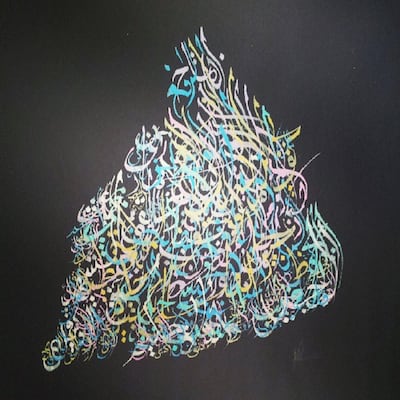A British city's skyline has been illuminated with neon art created by local residents as a way to share their Islamic faith and heritage with residents.
Bradford, a former industrial city in the north of England, has been lit up with three light installations of Al Asma Al Husna - known as the 99 Names of Allah - until the end of the month.
These Arabic names include "An Nur", meaning the light/the illuminator; "Al Wadood", meaning the most loving and "As Salaam", the giver of peace.
The creations are the brainchild of Razwan Ul-Haq, a British visual artist and calligrapher known for creating contemporary pieces seen across the UK and beyond.
Originally from nearby Burnley in Lancashire, Razwan has lived in Bradford for eight years and developed the light installation in conjunction with local charities "to spread light, love and peace across Bradford".
The project was also devised as a way to brighten up the skies while locals were stuck at home under coronavirus restrictions.

Razwan said the project illustrates the adaptability of Arabic calligraphy, a medium which he has utilised successfully for public art installations, museums, and even comic books tackling anti-Islamic sentiment.
"For me calligraphy is a way of life, and I think it can work in many different contexts", he told The National.
"When I was thinking of the names I was delving really deeply into the letters themselves and asking, how I can I really express those letters in a different way?"
His "Al Wadood" creations were inspired by the architecture of the Little Germany area of Bradford and the Bauhaus designers of the 1920s.
The design for the word "As Salaam" was inspired by the decorative calligraphy seen in the Grand Mosque of Bursa in Turkey, which includes 192 inscriptions by 41 different calligraphers.
Creating Arabic script using neon was a challenge, he said, as he was forced to keep his work simple to deal with the demands of the medium.
Working in conjunction with Neon Workshops in nearby Wakefield, Razwan said he was happy with the end result which came very close to his original designs.

"I think the challenge was making the neon distinctive, making them divine and to still have that splendour."
Another challenge was how to stand out in Bradford, which has a large Muslim population where Arabic signs are a common sight. This is where the idea for neon came in.
"There are over 100,000 Muslims in Bradford so there are already Arabic signs here, so it's not like Dorset or York where you can just do a piece of art", he said.
He was initially concerned by how the project would be received by locals due to the association between neon and nightlife.
"When you think of neon you don't really think of the Divine Names," he said.
However, he realised neon signs are a common sight in cities such as Lahore or Cairo, where they help to make mosques or businesses stand out from the crowd.
Local reaction to the installations has been "fantastic", Razwan said.
"I think together we managed to create engaging designs that people talked about. So in the end this just came together at the right moment."
He developed his interest in calligraphy from a young age, inspired by his Pakistani uncle, also a highly respected calligrapher, whose Arabic handwriting mesmerised the young Razwan.
"I was shocked because it was as if there was something mechanical at the end of his hand because his writing was so perfect," he said.
From there, Razwan developed his penmanship by learning from some brilliant calligraphers he met on his travels around the world.
The style he is most comfortable working with is Nastaliq, developed by master calligraphers from the 14th century and used in Urdu and Persian script.
Western art has also been an inspiration for Razwan, particularly LS Lowry, a painter whose works captured the realities of life in industrial England in the early 20th century. He said East Asian and Celtic art, such as the Book of Kells, also share a similar "serenity" to that seen in Islamic calligraphy.
Other major projects he has worked on include art created for the Tour de France in 2014, which at the time was the biggest Islamic letter in Europe.
He is currently exhibiting his work at the Bradford Industrial Museum, showcasing his calligraphy inspired by verses in Urdu by the national poet of Pakistan, Allama Iqbal.
Razwan says he is optimistic about the future of Islamic calligraphy and that interest has been "going crazy in recent years", quite in contrast to when he was younger.
"People are really interested. There are more and more demands for classical calligraphy".




